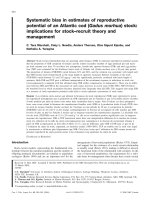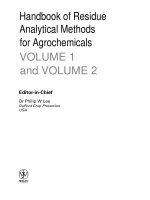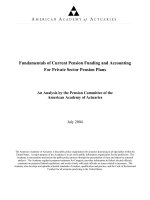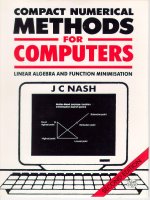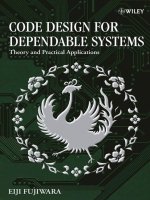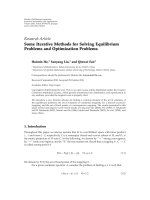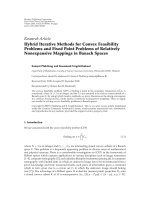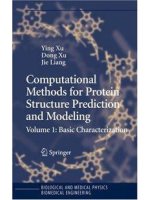Carbon emission allocation methods for aviation sector theory and experimental analysis
Bạn đang xem bản rút gọn của tài liệu. Xem và tải ngay bản đầy đủ của tài liệu tại đây (1.39 MB, 65 trang )
Carbon Emission Allocation Methods for Aviation Sector:
Theory and Experimental Analysis
ZHANG PENG
(Econ Dept, NUS)
A THESIS SUBMITTED
FOR THE DEGREE OF MASTER OF SOCIAL SCIENCES
DEPARMENT OF ECONOMICS
NATIONAL UNIVERSITY OF SINGAPORE
2011
Carbon Emission Allocation Methods for Aviation Sector:
Theory and Experimental Analysis
ZHANG PENG
(Bachelor of Engineering, Nanyang Technology University)
A THESIS SUBMITTED
FOR THE DEGREE OF MASTER OF SOCIAL SCIENCES
DEPARMENT OF ECONOMICS
NATIONAL UNIVERSITY OF SINGAPORE
2011
Acknowledgements
Firstly, I would like to express my gratitude to the National University of Singapore
for the privilege of pursuing a 2-year master program. I would like to extend my
sincere appreciation to A/P Anthony Chin, Department of Economics, National
University of Singapore (NUS), for his trust and guidance. The thesis would not
have been completed without his patient guidance, insightful instructions, and
continuous support.
Secondly, I would also like to thank Mr. Gari Walkowitz for his valuable insight on
the designing and conducting of the experiment, especially regarding the z-Tree
program. Additional to that, I would like to extend my sincere appreciation to Dr.
Wieland Müller for sharing his z-Tree code. His z-Tree code formed a very useful
reference for programming the codes used in this study.
Last but not least, I would like to thank all my friends who helped, supported and
accompanied me during my master program. The more indispensable being: Qu Chen,
Zhang Zilong, Zhou Xiaolu, Athakrit Thepmongkol, Chua Thiam Hao, Lam Yihong
and Lai Huiying. I truly appreciate all social and mental support provided by them.
i
Contents
Acknowledgements ........................................................................................................... i
Abstract ........................................................................................................................... iii
List of Tables ................................................................................................................... iv
List of Figures .................................................................................................................. v
List of Abbreviations....................................................................................................... vi
1. Introduction .................................................................................................................. 1
1.1 Global warming ..................................................................................................... 1
1.2 Economical instruments to alleviate global warming effect .................................. 2
1.3 International efforts on mitigating GHGs emissions ............................................. 3
1.4 European Union Emissions Trading Scheme ......................................................... 3
1.5 Emissions from aviation and including its emission into EU ETS ........................ 4
1.6 Literature review and motivation ........................................................................... 7
2. The Model .................................................................................................................. 11
2.1 Details of including aviation activities in EU ETS .............................................. 11
2.2 Design of the model ............................................................................................. 12
2.3 Hypotheses ........................................................................................................... 19
3. The Experiment .......................................................................................................... 21
3.1 Design of the experiment ..................................................................................... 21
3.2 Experimental implementation .............................................................................. 22
3.3 Experimental procedures ..................................................................................... 24
4. Results and Discussion .............................................................................................. 25
4.1 Average output in Benchmark period in both methods ........................................ 25
4.2 Average efficiency level in Benchmark period in both methods ......................... 27
4.3 Average output and efficiency in ETS period in both methods ........................... 28
4.4 Profit and Cost for aircraft operators in both methods ........................................ 30
4.5 Policy implication ................................................................................................ 32
5. Conclusion ................................................................................................................. 34
References ...................................................................................................................... 36
Appendix A: Statistical Tests ......................................................................................... 38
Appendix B: Personal Instruction Sheet ........................................................................ 50
Appendix C: z-Tree Interface ........................................................................................ 54
Appendix D: Mini Test .................................................................................................. 57
ii
Abstract
The European Union has proposed a Directive to include aviation activities in its
Emissions Trading Scheme by 2012. A permit allocation method has been announced
that it is relatively easy to implement and has a low administration cost. However,
careful scrutiny suggests that the allocation method does not favor energy efficient
aircraft operators and may undermine efforts to restrict growth of emission from the
aviation sector. An alternative permit allocation method is proposed in this study
which favors energy efficient aircraft operators and avoid excessive over competition.
The proposed method in this study is easy to implement with low administrative cost.
A Cournot model serves as the theoretical foundation upon which experiments are
designed to simulate the aviation industry under the proposed emissions trading
scheme. The equilibrium is calculated for each permit allocation method. Preliminary
results suggest that the outcomes from experiments are consistent with theoretical
outcomes.
iii
List of Tables
Table
Title of Table
Table 1.1
Evaluation of allocation methods
Page
9
Table 2.1
illustration of EU allowance allocation method
11
Table 2.2
Symbols in Equation 2.1 and Equation 2.2
12
Table A.1
Unpaired t test for output in Day 1 experiment ONE vs. experiment TWO
38
Table A.2
Unpaired t test for efficiency level in Day 1 experiment ONE vs. experiment TWO
39
Table A.3
One-sample test for output in Day 1 experiment ONE
40
Table A.4
One-sample test for output in Day 1 experiment ONE (Excluding extreme outputs)
41
Table A.5
One-sample test for output in Day 1 experiment TWO
42
Table A.6
One-sample test for efficiency in Day 1 experiment TWO
43
Table A.7
Unpaired t test for output in Day2 experiment ONE vs. experiment TWO
44
Table A.8
Unpaired t test for efficiency level in Day 2 experiment ONE vs. experiment TWO
45
Table A.9
One-sample test for output in Day 2 experiment ONE
46
Table A.10
One-sample test for output in Day 2 experiment TWO
47
Table A.11
One-sample test for efficiency level in Day 2 experiment ONE
48
Table A.12
One-sample test for efficiency level in Day 2 experiment TWO
49
iv
List of Figures
Figure
Title of Figure
Page
Figure 1.1
CO 2 Emissions by country in 2008
1
Figure 1.2
CO 2 Emissions (Tons/Capita) by country in 2008
2
Figure 1.3
CO 2 emissions by Sector EU-27 Million tons in 2007
5
Figure 1.4
Change of CO 2 emissions* among sectors compared to 1990’s level in EU-27
5
Figure 3.1
Experimental flow of one round
23
Figure 4.1
Average output and efficiency level in Benchmark period for both methods
25
Figure 4.2
Whisker plots of output distribution in Benchmark period for both methods
26
Figure 4.3
Whisker plots of efficiency distribution in Benchmark period for both methods
27
Figure 4.4
Average output and efficiency in ETS period for both methods
29
Figure 4.5
Whisker plots of output distribution in ETS period for both methods
29
Figure 4.6
Whisker plots of efficiency distribution in ETS period for both methods
30
Figure 4.7
Average profit for aircraft operator in both methods
30
Figure 4.8
Average cost for both methods
31
Figure 4.9
A comparison of the average cost in Benchmark Period and
ETS period for both methods
32
v
List of Abbreviations
Abbreviation
AEU ETS
CAC
EEA
EP
EU ETS
GHGs
IB
IPCC
LTO
MAC
NUS
ppmv
UNFCCC
Full Name
Augmented EU Emissions Trading Scheme
Command-and-control
European Environmental Agency
European Parliament
European Union Emissions Trading Scheme
Greenhouse Gases
Incentive-based regulations
Intergovernmental Panel on Climate Change
Landing/Take-off cycle
marginal abatement cost
National University of Singapore
parts per million by volume
United Nations Framework Convention on Climate Change
vi
1. Introduction
1.1 Global warming
The presence of global warming is confirmed by the observations of increased average
air and ocean temperature and rise of average sea level (IPCC, 2007). The accelerated
rise of the surface temperature is mainly attributed to the rapid increase of the
Greenhouse Gases (GHGs). Carbon dioxide (CO 2 ) is the most important
anthropogenic GHG and its annual emissions have grown about 80% between 1970
and 2004 to 38 gigatonnes (Gt). These emissions represented 77% of total
anthropogenic GHGs emissions in 2004 (ibid).
In 2008, 48% of the total CO 2
emissions were from China and United States as shown in Figure 1.1. However, CO 2
emissions per capita from United States were 3.4 times than the emissions per capita in
China in year 2008 (see Figure 1.2).
Emissions in Million metric tons
24%
26%
2%
6017.69
USA
5902.75
Russia
1704.36
India
1293.17
Japan
1246.76
Germany 857.6
3%
4%
China
24%
5%
5%
7%
Canada
614.33
UK
585.71
Others
6453.63
Figure 1.1 CO 2 Emissions by country in 2008
Secondary data retrieved from />
1
USA
19.78
Canada
18.81
Russia
12.00
Germany
10.40
South Africa
10.04
Japan
9.78
UK
9.66
China
4.58
Brazil
India
2.01
1.16
Figure 1.2 CO 2 Emissions (Tons/Capita) by country in 2008
Secondary data retrieved from />
1.2 Economical instruments to alleviate global warming effect
Numerous researches suggest that controlling the GHGs emissions hinges on two basic
instruments. These are command-and-control (CAC) and incentive-based (IB)
regulations (Carlsson and Hammar, 2002; Tietenberg, 1990). Incentive-based
mechanisms are widely accepted due to higher efficiency and lower cost compared to
CAC regulations (Baumol and Oates, 1988) in controlling emissions. Incentive-based
mechanisms can be further divided into two groups: price and quantity controls.
Price controls, such as emission tax, are the simplest method to charge the negative
environmental externality caused by the polluters. Therefore, price controls are one of
the most widely used economic instruments in environment protection. However, due
to the lack of certainty in controlling the overall amount of pollution,
environmentalists do not favor this option (Carlsson and Hammar, 2002). As a result,
2
price controls are not favored due to the uncertainty in effectiveness.
Quantity control in the form of an emissions trading scheme, is also known as capand-trade systems. In contrast to price controls, where the total amount of pollution is
uncertain, the cap of pollution quota ensures that the pollution does not exceed a
certain amount. In quantity control, cap-and-trade systems overcome the above
shortcoming through trading of allowances. The allocation of allowances is associated
with emission rights. Given the possibly windfall profits and the flexibility in
implementation, cap-and-trade is favored by government, environmentalists and
industry.
1.3 International efforts on mitigating GHGs emissions
The Kyoto Protocol (UNFCCC, 1997) committed industrialized countries commit to
decrease emissions of six types GHGs by 5.2% below 1990’s level over the period
2008-2012. The EU has also set medium and long term targets to restrict the GHGs
emissions. By 2020, EU aims to reduce 20% emissions below 1990’s level. The long
term goal is to stabilize the CO 2 at 450-550 parts per million by volume (ppmv) by
2050 (Anderson et al, 2005).
1.4 European Union Emissions Trading Scheme
The European Union Emissions Trading Scheme (EU ETS) is the largest multinational emissions trading scheme in the world (Ellerman, 2007) aiming at achieving
the target set by the Kyoto protocol. Aggregated emissions caps are imposed on the
most energy-intensive sectors such as cement, glass, ceramics, paper, steel and iron,
3
and power generation. Together these sectors consist of more than 10,000 installations
which are collectively responsible for half amount of the CO 2 emissions and 40% of
total greenhouse gas emissions in EU (MEMO/08/35, 2008).
In January 2008, a number of changes for the scheme had been proposed by the
European Commission, including introduction of a centralized allowance allocation by
an EU authority replacing the member governments, an increase share of auction
rather than allocating freely by grandfathering approach and most importantly,
extending the scheme to include aviation industry.
1.5 Emissions from aviation and including its emission into EU ETS
Figure 1.3 shows that emissions from the transport sector contribute 23% of the total
emissions in EU-27 region in 2007. Moreover, emissions from transport continuously
increased over 17 years while emissions from other sectors have been stable below
1990’s level (see Figure 1.4). Although, the emissions from civil aviation within EU27 contributed to 2% share in transport sector, the world aviation activities accounted
for approximately 3% of anthropogenic global warming in 2004 (Enerdata, 2007; EEA,
2009).
Despite the fact that GHGs emissions from other forms of transportation have
stabilized in recent years, aviation constitutes one of the fastest growing sectors and
emissions continue to increase (USGAO, 2000). Global air passenger traffic (revenue
passenger-kms) has increased by 9% per annum since 1960 which is 2.4 times of the
growth rate of global mean GDP (IPCC, 1999). By 1997, growth rate in global air
passenger traffic had slowed to approximately 5% per year due to a matured aviation
4
industry in some parts of the world. This growth rate is now expected to be sustained
until 2015. The high growth rate of aviation industry implies high growth rate of
GHGs emissions. In the European Union, CO 2 emissions from international aviation
increased by 85% between 1990 and 2004, higher than maritime emissions or land
transportation sectors (EEA, 2007).
Public Electricity and Heat Production
1392.5
Transport 966
17%
3%
33%
3%
Residential 413.1
Industrial Process 300.9
4%
Commercial/Institutional 164
7%
10%
Petroleum Refining 134.6
23%
Iron and Steel 115.6
Others 700
Figure 1.3 CO 2 emissions by Sector EU-27 Million tons in 2007 (EEA, 2009)
Figure 1.4 Change of CO 2 emissions* among sectors compared to 1990’s level in EU-27 (EEA, 2009)
*Excluding LULUCF (Land Use, Land-Use Change and Forestry) Emissions and International Bunkers
** Excluding International Bunkers (international traffic departing from the EU)
***Emissions from Manufacturing and Construction and Industrial Processes
5
Given the target to stabilize CO 2 emissions at 450ppmv by 2050 in the EU, the
proportion of total carbon emissions from aviation is set at 79% by 2050. If the
corresponding target is changed to 550ppmv by 2050, the proportion will be reduced
to 39% (Anderson, 2005). Simulations show that aircraft emissions in the absence of
any restriction will account for the majority of CO 2 emissions covered by the EU ETS.
This will make it difficult to meet the EU reduction target of 20% below 1990’s level
by 2020 for total EU emissions.
th
On 9 July 2008 the European Parliament (EP) decided to include aviation in the EU
ETS. The EC Directive (Directive 2008/101/EC) encompasses the following key
elements:
(1) The EU ETS will include all flights departing from or landing at the EU airports
from 2012. Aircraft operators will be obliged to comply with the regulation to
surrender allowances for CO 2 emissions.
(2) In 2012, the total quantity of allowances to be allocated to aviation sector will be
97% of the historical aviation emission which is the average total emission level in
2004-2006. This emissions cap will be decreased to 95% in 2013.
(3) Allowances will be allocated to each aircraft operator in proportion to tonnekilometers flown during the reference year in 2010. The benchmark will be calculated
from dividing the EU-wide cap for aviation sector by the total tonne-kilometres flown
in reference year by all aircraft operators included in the EU ETS. The first reference
6
year will be 2010. Thereafter, the reference years will be the calendar year ending 24
months before the beginning of next trading period.
(4) In the first year of inclusion of aviation into the EU-ETS, Certified Emissions
Reductions (CERs) and Emission Reduction Units (ERUs) from the Clean
Development Mechanism and the Joint Implementation of the Kyoto Protocol may be
used up to 15% of an aircraft operator's EU ETS allocation in 2012.
(5) Allowances allocated to aircraft operators will be only valid within the aviation
sector. For example, allowance in aviation sector cannot be sold to other trading
sectors except with the aviation sector. However, additional allowances can be
purchased from other sectors by aviation sectors under EU ETS.
(6) Allowances not used in 2012 can be ‘banked’ to the third trading period of the EU
ETS which implies unused allowances can be carried over for use up to 2020.
(7) A special reserve consisting of 3% of allowances will be established for new
entrants and fast growing aircraft operators.
1.6 Literature review and motivation
There are several studies on the EU ETS and the aviation sector. These include
variability of coverage of GHGs, geographical scope, allocation method, monitoring
method, verification mechanism and trading entities in effectiveness of controlling
emissions which are discussed by Wit et al. (2005). Mendes and Santos (2008) studied
the impact on both supply and demand impacts in aviation industry and Anger (2010)
7
estimated the impacts of including aviation in EU ETS on air transport output and
macroeconomic effects. Scheelhaase et al. (2010) studied the impacts on competition
between European and non-European network aircraft operators.
Wit compared the pros and cons for variant frames, and suggested that the future
frame should integrate the following principles: (1) market access for new entrants, (2)
compatibility with the polluter-pays principle, (3) credits for early action, and (4) data
availability.
Mendes and Santos estimated the impacts from the perspective of supply and demand.
The results suggest that the impacts are likely to be minimal due to the high abatement
cost and inelastic demand. Anger demonstrated the impacts on both air transport
output and macroeconomics are negligible. The E3ME model estimated that there
would be nearly 7.4% reductions of CO 2 emissions incorporating the aviation into EU
ETS. Furthermore Scheelhaase et al. concluded that non-European network aircraft
operators would gain a significant competitive advantage compared to European
network aircraft operators. This is because non-European network aircraft operators
tend to operate relatively efficient long-haul services into Europe. European network
aircraft operators instead, have a relative inefficient short-haul feeder network within
the scope of the ETS.
This study analyzes the impact of different allowances allocation method on the
aircraft operators. Different allowances allocation methods such as grandfathering,
benchmarking, auctioning, baseline and even for no allocation plan have been
discussed. With the comparison, Wit et al. concluded that benchmarking approach is
8
the most preferred method for aviation industry. Grandfathering apparently contradicts
the polluter-pays principle, although it is attractive to emitters, because it favors vested
interests (Cramton and Kerr, 2002; Cames and Deuber, 2004). In addition, baseline
approach has significant drawbacks which are unfavorable for new entrants and
aircraft operators which achieve a remarkable emissions reduction (Wit et al., 2005).
Lastly, despite being the most efficient option, the auction approach places too much
burden on the aircraft operators. Hence, benchmarking approach is adopted as the
preferred allocation method in EU Directive.
Table 1.1 Evaluation of allocation methods (Wit et al., 2005) Legend: + positive; - negative; 0
neutral
Data availability
Market access for new
entrants
Compatibility with
polluter-pays principle
Credit for early action
Grandfathering
-
Benchmarking
0
-
Auctioning
Baseline
No allocation
+
-
+
0
+
+
+
-
0
+
0
+
-
+
+
0
+
The EU method has many advantages. The biggest merit of EU method is easy to
implement with a low administration cost. However, careful scrutiny suggests that the
EU method does not favor aircraft operators with high energy efficiency. If energy
efficiency level is defined as the ratio of Tonne-Kilometers over quantity of fuel
consumed (see Table 2.2). Under the EU method, aircraft operators have strong
incentives to increase their market share during Benchmark period in order to receive
more free allowances in the ETS period. This may result in over competition for
market share and undermine the efforts of containing the emission growth rate in
aviation sector. An alternative allowances allocation method, which will be referred as
9
Augmented EU Emissions Trading Scheme or AEU ETS, is proposed which favors
energy efficient aircraft operators where there is no incentive to compete in market
share to receive allowances. Further, the AEU ETS is easy to implement with a low
administrative cost because the data required is already available.
Aircraft operators in the United States perceived this as an act of exclusion and
containment in the EU aviation market. The EU Directive has resulted in strong
international resistance, from the United States and other countries such as Canada,
Australia, China and Japan, because such exclusion is incompatible with the Chicago
Convention.
The various allocation methods have not been subject to empirical evaluation. Few
experiments have been carried out to test the responses of participants in a laboratory
environment. Experiments are designed in this study to simulate responses to different
allocation methods. The Cournot framework forms the bases of evaluation and the
equilibrium solutions are calculated for each allocation method.
10
2. The Model
2.1 Details of including aviation activities in EU ETS
Based on the Directive, the allowances allocation method can be expressed in the
following way:
Free allowances allocated to each aircraft operator in 2012 are
tonne - kilometers flown by the aircraft operator in the benchmark period
EU wide cap ×
tonne - kilometers flown by all aircraft operators in the benchmark period
EU wide cap:
average emissions from aviation in EU from 2004-2006
Benchmark period:
2010-2011
Table 2.1 Illustration of EU allowance allocation method
EU wide cap
100
Tonne-Kilometers by one particular aircraft operator
800
Tonne-kilometers by all aircraft operators
10000
The allowances located to the aircraft operator are
100 ×
800
=8
10000
The allowances which are allocated to aircraft operator are based on share of TonneKilometers flown during the Benchmark period. The plan favors those with large
market share. Ideally, the method should favor the operators with high energy
efficiency. High efficient aircraft operators should be granted more allowances.
Furthermore, under the EU method, the aircraft operator has incentives to increase its
market share during the Benchmark period to maximize allowances. We proposed the
AEU ETS method in which allowances are allocated based on energy efficiency in
place of market share. This encourages the aircraft operators to utilize newer and
11
lighter planes with better engine technology and lighter aircraft weight (Wit et al.,
2005).
2.2 Design of the model
This study incorporates the emissions trading scheme into the basic Cournot model.
The new Cournot model is used to imitate the competition of aviation industry under
emissions trading scheme.
In the theoretical model, market is defined as a single LTO (Landing/Take-off cycle)
and restricted to two players, i.e., two aircraft operators compete in a single route
based on quantity adjustment. Player i can choose its output (q i ) and efficiency level
(e i ) to maximize the profit. The EU ETS and AEU ETS methods are given as follows:
qi
EU ETS, EU A i = γ ×
q +q
j
i
ei
AEU ETS, AEU A i = γ ×
+
e
e
j
i
Equation 2.1
Equation 2.2
Table 2.2 Symbols in Equation 2.1 and Equation 2.2
EU Ai
Free allowances allocated to aircraft operator i under EU ETS
AEU Ai
Free allowances allocated to aircraft operator i under AEU ETS
γ
EU wide cap
qi
Output (No. of Tonne-Kilometers) chosen by player i
ei
Efficiency level chosen by player i which is defined as a ratio of TonneKilometers over Quantity of fuel consumed
ei =
No. of Tonne - Kilometers
Tonne of fuel consumed
The price of allowances is exogenous. This is because the current price for allowance
12
for other sectors is trading between a narrow range of between 10-30 Euros. Also the
marginal abatement cost (MAC) in aviation industry is higher than the current
allowances price (Wit et al., 2005; Mendes and Santos, 2008). The entire aviation
industry is assumed as a net buyer of the allowances from other industry sector in EU
ETS. Anger and Köhler (2010) have indicated that the impact of aviation activities on
the price of allowances is negligible.
Aircraft operators can switch to newer aircraft which employs energy efficient
technology. However, this may be at the expense of incurring cost. A simple linear
cost function of efficiency level c(ei ) = α + βe i is assumed in this model. It simplifies
the derivation of the Nash equilibrium solution.
In summary, the model is set up with following prerequisites
(1) Two players in the market compete against each other in output
(2) Unit price of allowance is exogenous
(3) Players in the model are net buyers of the allowances
(4) Cost function is linear with the efficiency level
Firm i’s profit function under EU ETS and AEU ETS is given in two periods. Period 1
is the Benchmark period and period 2 is ETS period where firms are included in the
ETS.
I. Profit function under EU ETS
(a) Benchmark Period
EU π 1
i
= a − b(q1i + q1j ) q1i − (α + β e1i )q1i
Equation 2.3
13
(b) ETS Period
qi
qi
EUπ 2i = a − b( q2i + q2j ) q2i − (α + β e2i ) q2i − Pa i2 − γ i 1 j
q1 + q1
e2
[
]
Equation 2.4
II. Profit function under AEU ETS
(a) Benchmark Period
[
]
AEUπ 1i = a − b(q1i + q1j ) q1i − (α + βe1i )q1i
Equation 2.5
(b) ETS Period
qi
ei
AEUπ 2i = a − b(q2i + q2j ) q2i − (α + β e2i )q2i − Pa i2 − γ i 1 j
e1 + e1
e2
[
]
Equation 2.6
Subject to the following constraints
(
)
Equation 2.7
b q2i + q2j − a ≤ 0 ,
(
)
Equation 2.8
α + βe2i + b(q2i + q2j ) − a ≤ 0
Equation 2.9
b q1i + q1j − a ≤ 0 ,
The first two constraints ensure that the unit price of output is positive and Equation 2.9
ensures that profit is positive prior to purchase of emission allowances. These
constraints allow an element of reality as it reflects realities of the business world.
The unit price of allowance under EU ETS and AEU ETS is given in the last element of
Equation 2.4 and 2.6. For example,
qi
qi
Pa i2 − γ i 1 j
q1 + q1
e2
qi
ei
and Pa i2 − γ i 1 j
e1 + e1
e2
.
14
The aircraft operator possesses
q 2i
e2i of permits to comply with the regulation;
q1i
i
j
q1 + q1
γ
e1i
is the free permits allocated to the aircraft operator according to
i
j
e1 + e1
different allocation methods. Since the aviation industry is expected to be the net
or
γ
purchaser of the permits (Wit et al., 2005), it is unlikely for them to sell extra permits in
the ETS market.
The Nash equilibrium solutions are given below
I. Nash equilibrium solutions with EU ETS
a)
e2i = e2j =
b)
e1i = e1j = 0
Pa
β
Equation 2.10
Equation 2.11
Since profit function is monotonically decreasing with increasing e1i
c)
p
∂π i
= a − 2bq2i − bq2j − α − βe2i − ia = 0
i
∂q2
e2
Equation 2.12
The response function for player i is
a −α −
q2i =
Pa
− βe2i − bq2j
e2i
2b
Equation 2.13
Similarly, the response function for player j is
a −α −
q2j =
Pa
− βe2j − bq2i
j
e2
2b
Equation 2.14
By solving Equation 2.13 and Equation 2.14, the Nash equilibrium solution is
q2i = q2j =
a − α − 2( Pa )1 2 β 1 2
3b
Equation 2.15
15
d)
∂π i
∂q1i
(
)(
= a − 2bq1i − bq1j − α − βe1i × q1i + q1j
)
∂π j
= a − 2bq1j − bq1i − α − βe1j × q1i + q1j
∂q1j
(
) (
2
+ Pa γq1j = 0
)
2
+ Paγq1i = 0
Equation 2.16
Equation 2.17
The Nash equilibrium solution is
q =q =
i
1
j
1
a −α +
(α − a )2 + 3bPaγ
6b
Equation 2.18
II. Nash equilibrium solutions with AEU ETS
∂π i
= Pa q2i (e2i ) −2 − βq2i = 0
i
∂e2
a)
Pa
e2i = e2j =
Equation 2.20
β
∂π i
e1i
=
p
γ
a
b) ∂e1j
e1i + e1j
(
e =e =
i
1
c)
j
1
Equation 2.19
a −α −
)
2
− βq1j = 0
(a − α )2 − 3bPaγ
Equation 2.21
Equation 2.22
2β
p
∂π i
= a − 2bq2i − bq2j − α − βe2i − ia = 0
i
∂q2
e2
Equation 2.23
The response function for player i is
a −α −
q2i =
Pa
− βe2i − bq2j
i
e2
2b
Equation 2.24
Similarly, the response function for player j is
16
a −α −
q2j =
Pa
− βe2j − bq2i
j
e2
2b
Equation 2.25
By solving Equation 2.24 and Equation 2.25, the Nash equilibrium solution is
a − α − 2( Pa )1 2 β 1 2
q =q =
3b
i
2
d)
Equation 2.26
j
2
∂π i
= a − 2bq1i − bq1j − α − βe1i = 0
∂q1i
q1i =
Equation 2.27
a − α − βe1i − bq1j
2b
Equation 2.28
Similarly,
q1j =
a − α − βe1j − bq1i
2b
Equation 2.29
Solve Equation 2.28 and Equation 2.29, we can obtain
q1ij ==
(
aa −−α β e1ij −− 22ee11ji
+
33bb
3b
)
Equation 2.30
Assumptions on the parameters for the experiments are as follows
(
i
j
a) Unit price of output: a − b q + q
i
b) Cost: α + βe
) where, a = 100
b =1
α = 0 β =2
c) The price of the allowance in the emissions trading scheme is announced as follows:
qi
q i
Pa i2 − γ i 1 j Unit price of allowance: Pa = 50 EU wide cap: γ = 15
q1 + q1
e2
Therefore, the Nash equilibrium solutions are
I. EU ETS
q1i = q1j = 35.1 q2i = q2j = 26.7 e1i = e1j = 0 e2i = e2j = 5.0
17
